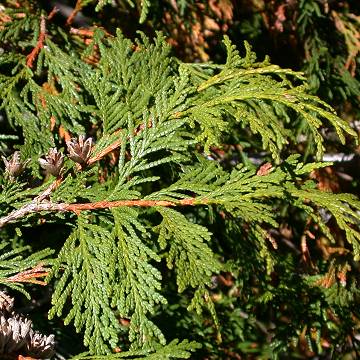

Thuja occidentalis - (image 1 of 7)
Taxonomy
Family: Cupressaceae
Habitat
Calcareous springy slopes, bogs, swamps. In the east can also occur on rocky upland sites.
Associates
Distribution
Quebec and Nova Scotia west to Hudson Bay, south to NJ, OH, northern IN, IL, WI, MN, and in mountains to NC and TN.
Morphology
Evergreen, pyramidal tree to 20 m. Bark grey or reddish-brown, shreddy. Branchlets soft and flat, numerous from the axils of the lateral leaves. Leaves scale-like, closely imbricate, broadly ovate to rotund, 2-4 mm, glandular. Female cones oblong-ovoid, woody, with 4-6 pairs of overlapping scales, the upper and lower scales sterile, the middle each with 2-3 ovules; seeds winged.
Notes
Flowers NA
Wetland indicator: Facultative Wetland
Also called Arborvitae, meaning "Tree of Life", this is a popular ornamental tree.
References
Gleason, Henry A. and A. Cronquist. 1991. Manual of Vascular Plants of Northeastern United States and Adjacent Canada. Second Ed.
The New York Botanical Garden. Bronx, NY
Swink, F. and G. Wilhelm. 1994. Plants of the Chicago Region.
Indiana Academy of Science. The Morton Arboretum. Lisle, Illinois.
|
Michael Hough © 2005 |